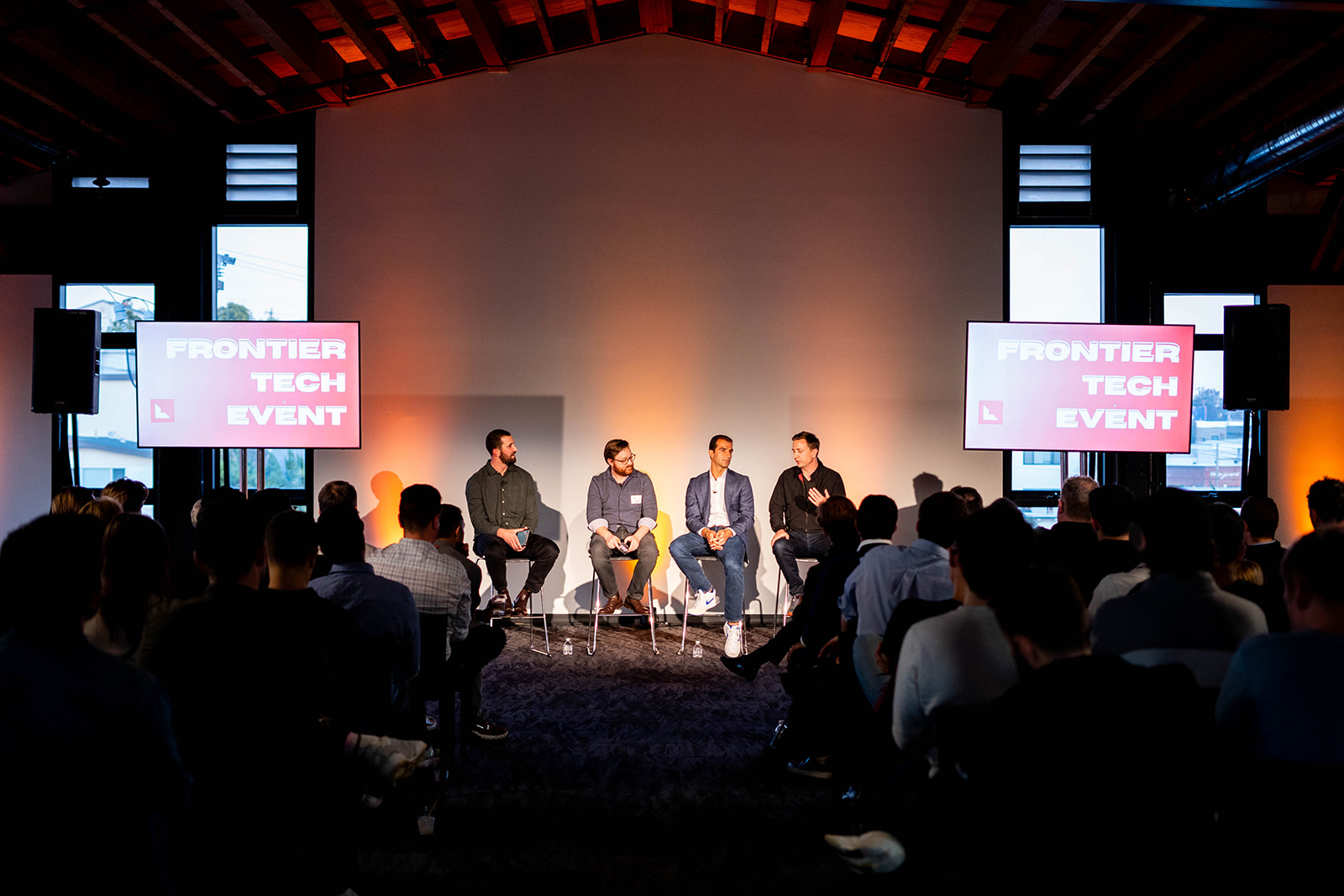04/17/2024
Enterprise
Founder insights on the future of Frontier Tech from Anduril, Saronic, and Astranis

Lightspeed has an extensive history of investing in foundational technologies globally, including Anduril, SpaceX, Saronic, Dexterity, Kodiak, Aurora, Reliable Robotics, Supercritical, and Nest. And we’ve been investing in frontier tech companies for nearly a decade, building a portfolio of close to 50 companies across the sector with over $680 million invested to date.
Earlier this month, Lightspeed hosted its inaugural Frontier Tech event in the heart of El Segundo. Over one hundred of LA’s top frontier tech founders, operators, and investors came together to discuss the future of civilization and technology’s role in shaping it.
Lightspeed Partner Connor Love led the evening’s discussion with Brian Schimpf, CEO of Anduril, Dino Mavrookas, CEO of Saronic, and John Gedmark, CEO of Astranis. Connor defined Lightspeed’s view of frontier tech as companies “pushing the boundaries of both hardware and software engineering to a point where traditional industries wouldn’t be comfortable.”
The CEOs shared insights leading their frontier tech companies, including their approaches to AI, complex go-to-market strategies, and the challenges of building highly technical products. Below are three of the evening’s main takeaways. Comments have been edited for clarity.
Smaller is often better—and more nimble.
“When I started doing this, around 2007, it was absurd that any new company could do anything in defense. It was like, obviously, Boeing will solve all of our problems,” Schimpf told the crowd at the start of the discussion. “It’s just really crazy how much the conversation has changed” in favor of smaller, nimbler companies.
So what changed?
“Look at what happened, trying to ramp production during Ukraine,” Schimpf said. “We couldn’t get the weapons we needed, we couldn’t drive things at scale. I think the combination of the urgency around China, the realizations of what happened in Ukraine, and the pace at which Silicon Valley has innovated—particularly on software and IT technology—has completely changed the model of how the DoD operates. For the first time they are buying technology in a free market commercial strategy at scale, compared with the historic approach of measured research and development over a five-to-ten-year period. They’re now saying, what can you do for me in a year? I will buy $100 million worth or $30 million worth. That’s actually a very big deal.”
Mavrookas agreed that the primes aren’t “building capabilities to prove out new operational concepts to the government,” which is a gap he filled with his approach to designing boats for the U.S. Navy.
Gedmark then put things in terms of satellite companies. “The major satellite manufacturers, which are also coincidentally the major defense primes—Boeing, Lockheed, and Northrop—they really don’t make investments in new products anymore on their own dime, right? They wait until there’s a U.S. government program that will pay them a ton of money.” With new attitudes emerging in the defense industry, however, there are openings for smaller companies to take initiative.
Treat the defense industry like a partner—and speak their language.
Mavrookas emphasized that his company treated the U.S. Navy as a design partner from the beginning. “We sat down with the Navy and asked, What mission are you trying to accomplish? What do you actually want to do with these boats? What are the constraints and restraints that you have? How far do you need them to go? How much power do you need to provide? Help us understand the mission setting, then we’ll go build a boat around the mission, not the other way around. And so, bringing the Navy in as a design partner, and working with the end users was by far the most valuable thing for us.”
But speak your customer’s language, Gedmark advised before recalling a story of an industry conference he attended early in his career, when he and his co-founder were still working out of their apartment. It was a smaller conference attended mostly by senior executives at major defense companies who, as it turned out, were eager to hear about the smaller, more nimble satellites he was designing. “Many of those executives,” Gedmark remembered, “were highly technical. And as soon as we sort of got into the meeting, they wanted to riff on the technical specs most interesting to them: frequency bands, coverage areas, EIRP levels. It’s really important to be able to talk at that level with your customers.”
In order to maintain defense superiority, we need to build more.
“In modern history global power has been determined by naval power, and naval power has been determined by who has the most ships,” Mavrookas recalled once being told by a four-star Navy admiral. “During World War II we were the most powerful navy because we had the most powerful shipbuilding industry. Today, China has 50% of global shipbuilding capacity. They actually have 250 times the shipbuilding capacity of the U.S.,” he told the crowd, emphasizing that a power imbalance like that won’t help the U.S. deter China from invading Taiwan or “basically doing whatever they want.”
The solution is restoring sophisticated industrial capacity in the U.S.— which could be fertile territory for new startups. “Next generation manufacturing, especially for aerospace and defense, is extremely ripe,” Schimpf said. “How do you actually design, build, and produce systems at scale in a modern way? That area is completely underserved.”
At Lightspeed, we believe advancements in technology are fundamentally transforming the world. Artificial intelligence innovation has accelerated this change, but other core technological developments like advanced robotics, alternative energy sources, and cheaper sensors are fueling a revolution in how civilization will function. As we continue to invest in transformative technology, we believe this frontier tech will only attract more exceptional founders like Brian, Dino, and John.

